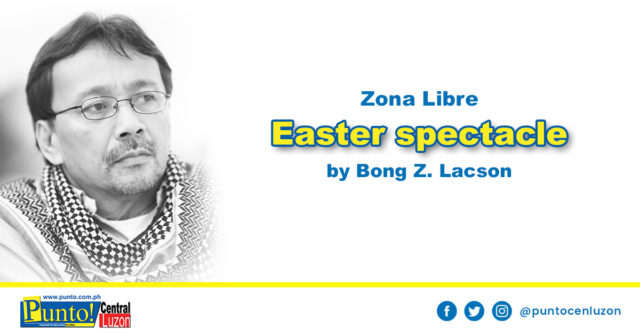EASTER SUNDAY has always been the centerpoint of the observance of the Holy Week in the small town of Sto. Tomas, just seven kilometers south of the capital city of San Fernando.
As a matter of course, Easter Sunday is celebrated as the fi esta in Poblacion, taking precedence over the official July 3 feast day of the patron St. Thomas the Apostle.
Or yet again, the resurrection an occasion of celebration for the apostle too with his affirmation of the divinity of the Risen Christ thus: “Dominus meus et Deus meus” (My Lord and my God).
Over the years, Thomasians have gladly acknowledged and observed Easter Sunday as the feast of all feasts. Those who already reside abroad or other nearby provinces always find time to go home and be with their cabalens (townmates) in commemorating the Maleldo (Holy Days).
So it has always been from the 19th century – said old folk – that Easter Sunday is celebrated with pomp and pageantry unique to Sto. Tomas.
While the salubong – the first meeting between the Virgin Mother and the Risen Christ – is celebrated in all Catholic churches, here the event is spiced up with a puso-puso – a multi-layered heart-shaped funnel (resembling an inverted flower) that opens up layer by layer after each chanting of the Regina Caeli Laetare, raining confetti and petals on the image of the mourning Virgin Mother below until a little girl dressed as an angel descends from it on a calo (a tiny swing-like contraption) to take the black veil off Mary. At this point, the curtain that separates the Mother and her Risen Son is opened for their joyful salubong.
The Easter procession then begins, with the town’s fairest maidens in their best ternos and formal gowns as sagalas – three ciriales, the cross and candle bearers at the lead; a banderada, the bearer of the Vatican flag, twelve pretty lasses called estabats (after their melancholic hymn Stabat Mater Dolorosa) who sing praises and shower with petals the Atlung Maria (Three Marys) symbolizing the Virgin Mother, Mary Magdalene and Mary Cleofas. By tradition, the center – the spot of the Virgin – is reserved for the most beautiful of the three sagalas.
The procession ends in church with a High Mass. By noontime, the faithful congregate anew at the churchyard for the burning of the effigy of Judas Iscariot.
Atop a scaffolding, Judas – garbed in red, sporting a Van Dyck and FPJ sideburns since the ‘60s – is ignited by pyrotechnic ravens and then twists, turns upside down, rotates and starts exploding from the legs up the arms, the body, and finally the head with the loudest bang. (In the town’s farming past, the bang of Judas’ head was taken an augury of the year’s rice harvest – the louder the blast, the greater the harvest; a dud foreshadowed utter disaster).
That used to cap the annual Holy Week celebrations in Sto. Tomas. In 2009, a new tradition was birthed in the Sabuaga Festival.
Sabuaga comes from the combination of sabuag (scatter) and sampaga (flowers) – the sagalas’ showering of petals on the image of the Virgin Mary in “veneration of her keeping the faith and oneness with her Son in His sufferings, thus her rewards in His joyful resurrection.”
Hence, petals and confetti will literally rain on the processional route around Poblacion, starting 2 p.m. of Easter Sunday as revelers join groups coming from the town’s seven barangays in street dancing.
At the town plaza where the revelry culminates, the groups in their most exotic costumes reflective of the product of the barangays they represent – pottery for Sto. Niño, caskets for San Vicente, fish for Poblacion, garments for Moras de la Paz, tinsmith for San Matias… — will each do its own interpretative dance presentation, on the theme sabuag sampaga, naturally. Judges coming from the arts, culture and tourism sector will proclaim the winners.
Sabuaga has since served as a fitting climax to the Holy Week celebration in the province. Indeed, the Maleldo in the City of San Fernando highlighted by the actual crucifixion rites in Barangay Cutud on Good Friday finds culmination in the joy of Easter Sunday’s Sabuaga in Sto. Tomas, which for the longest time was but a barrio of the capital town until its weaning in 1952.





